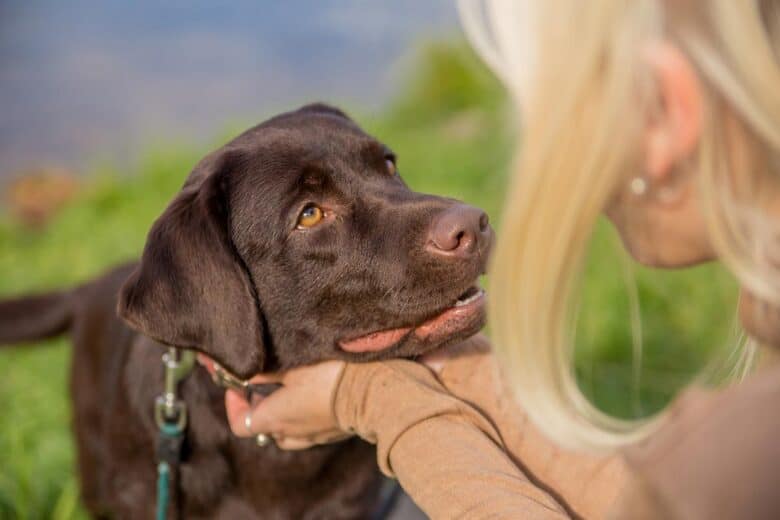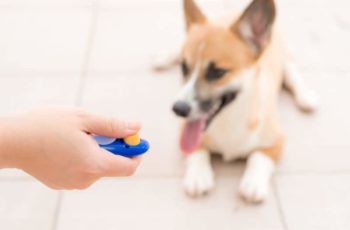This post may contain affiliate links. We may earn money or products from the companies mentioned in this post.
If you’ve decided you would like to bring a dog into your family, it is a great idea to adopt from a shelter or rescue.
These dogs are in desperate need of happy homes, and the organizations that care for and rehome these dogs make sure their pups are ready to move in with a family, both in terms of their health and behavior.
But exactly how long does it take to adopt a dog from a shelter or rescue?

There are two parts to this question.
First, there is the matter of how long it might take you to find an available dog who will make the perfect addition to your family.
Second, you’ll also need to consider how long it takes to complete the actual adoption process.
Read on as we look at both of these factors and what kind of timeline you can expect when adopting a dog into your family.
Contents & Quick Navigation
How Long Do Dogs Stay In Shelters Or Rescues?
While waiting to adopt a dog might seem like it takes forever for you, imagine how long it must feel like for the dog, with their shorter lifespan and the turmoil and uncertainty of losing their home and living in temporary accommodations.
When dogs are brought into a shelter or rescue, they need to be thoroughly cleaned and groomed, medically examined, behaviorally evaluated, vaccinated, and possibly spayed or neutered before they are ready to find new homes.
Unless the dog has a particular problem that requires extra treatment, they will be ready for adoption in about a week. For most dogs, they will be out of the shelter and into their forever homes not long after this.
But for other dogs that are considered less desirable due to age, breed, or other factors, they may find themselves waiting significantly longer. I have heard of dogs living in temporary accommodation for as long as five years before finding their new forever home.
While some shelters have strict “no-kill” policies, others will put dogs down if they cannot be rehomed within a certain period of time.
The ASPCA estimates that around 400,000 shelter dogs get put down each year. This is not necessarily inhumane, and no-kill shelters are not necessarily better than others. No-kill policies can lead to dogs spending years in terrible conditions.
How Long Does It Take To Find A Dog To Adopt?
Most shelter dogs tend to get snapped up pretty quickly once they are available for adoption. By the time they get a profile on an adoption website, most shelters will already be in conversation with someone about taking them home.
Most of the time, if you respond to a dog’s online adoption profile, you will be told that this particular dog already has a home.
Then why do shelters and rescues even make these profiles? Well, for one, they help drum up interest and encourage people to get in touch about adopting.
When you do get in touch with them, the shelter will suggest that you complete an online form registering your interest in adopting. You’ll be asked to answer questions about yourself, your lifestyle, and the kind of dog you are looking for.
This helps the agency determine whether you are a suitable pet parent for any of their charges and what kinds of dogs will make the best match for you.
They will then keep your registration on file for between three and six months and get in contact with you when a suitable dog becomes available.
If you register with one or two local rescues and shelters, you will usually be contacted within two months with a suitable pup. Of course, if you are looking for something very specific, such as a certain breed or a dog of a certain age, you may need to wait a bit longer.
How Long Does The Adoption Process Take?
Once you have been matched with a suitable dog, there are still quite a few things to do before your adoption can be finalized.
Specifically, you will need to have a phone interview with the rescue so they can ask you more questions about yourself, your living situation, and your experience with dogs.
If this goes well, the rescue will also probably want to do a home visit to verify the information that you have provided and to determine your home is suitable for your new dog. The agency will want to move on this pretty quickly, so it will depend on your availability.
At the same time, you will want to visit your future dog where they are staying to make sure you get along and that you are ready to take the dog home.
Again, the foster parents who are temporarily caring for the dog tend to be flexible and available to make these visits happen, so how long it will take depends mostly on your scheduling and availability.
Once this is done, everyone is happy, and fees have been paid, your dog can be transferred to your care.
Exactly how long this process will take depends partially on who you are adopting from. A large organization like the Humane Society might be able to get through all of this within a few hours depending on your availability.
It could take anywhere from a few days to a week for a volunteer-run organization to do the same due to their more limited resources.
Bear in mind that if you have very limited availability and make this process difficult, the shelter or rescue could decide that you are not a suitable match for the dog.
When dogs arrive in their new home after being in a shelter, they generally need more attention in the first week than they will later on. The agency will want to know that you have the time to commit to the process.
You can read our guide on adopting from a shelter vs. buying from a breeder here.
How Long Do Rescue Dogs Need To Adapt?
When you bring your rescue dog home, it will take them a little while to adapt to their new surroundings and start to feel like a member of their new family.
On average, it takes shelter dogs somewhere between six and eight weeks to fully adjust to their new home. Some will be faster, while others will need more time. It depends a lot on the type of dog, their age, and the living circumstances they are coming from.
Fortunately, there are a number of things you can do to help them adjust more quickly.
First, you can have everything you need prepared to make it feel like a safe space. This includes a comfy bed, a few toys, and their own bowl. The rescue may give you something that they were already sleeping with to make their new bed smell more like it belongs to them.
They should also give you a sample of the food that your dog has been eating. You should keep them on the same food, slowly adding in the food that you plan to feed them in the long run. Gradually increase the ratio of new food for a period of two to three weeks until they are comfortably eating with no digestive upsets.
It is important to realize that your new rescue dog might be afraid of their new surroundings. To help calm them and also bond with them at this time, it is important to comfort them. Soft stroking and speaking in a soft voice are the best things to do. Keep your home fairly quiet and as non-chaotic and calm as possible while your new pet adjusts.
Also, it is important to let them get used to any immediate family they will be living with day-to-day before introducing them to others. Meeting a lot of new strangers can be overwhelming for them, and you may not yet have enough control over them to manage their behavior.
Can The Adoption Process Be Too Fast?
While you will no doubt want to bring home your new canine family member as quickly as possible, the adoption process can be too fast. In fact, if the adoption process is too quick, this should be a red flag.
It takes time to properly assess dogs and prepare them for adoption and to assess whether you are a suitable match for the dog. If the adoption process is too fast, it could mean the agency is skipping some of the important steps.
Does that really matter? Yes. For example, you could end up taking home a sick dog that doesn’t live for long, which is an experience that can traumatize young family members. Alternatively, you could end up with a dog with unidentified behavioral problems that can cause havoc in your home.
Sometimes, agencies will want you to wait a few days before taking your dog home as a bit of a “cooling off” period. This is because the decision to adopt can be impulsive, but your relationship with the dog could last anywhere from 10 to 15 (or more!) years.
The last thing they want is the dog they rehomed being left homeless again because they have been placed somewhere unsuitable.
So, while the wait may be frustrating, it is important to remember that there are many good reasons why the process of adopting a rescue or shelter dog needs to take a little time.
Read our complete guide to adopting a Labrador retriever here.
FAQs About Adopting A Dog
Is it hard to get approved to adopt a dog?
Considering we are talking about dogs in need of homes, it can feel like the requirements for adopting a dog from a shelter or rescue are high, but there is a good reason for this.
These dogs often come from difficult backgrounds, so they need someone with time, patience, and sometimes experience to care for them. This is why shelters and rescues probe more about your lifestyle than breeders. They know that these are special pups who need just the right circumstances to thrive.
How much does it cost to adopt a dog?
Adopting a dog is not free, as rescues and shelters need to recoup the costs of caring for the dog and other essential things such as vaccines and spaying or neutering.
You can expect to pay around $500 for your average shelter dog. This may be less for older dogs and more for puppies. This may seem expensive, but it is good value for money, as you will not need to pay for your dog’s vaccinations and immediate medical care.
At what age can you adopt a puppy?
Puppies usually stay with their mothers until they are 8 to 10 weeks old, so you usually need to wait until they are a bit older to take them home. In some rare cases, rescues may let you take home a puppy sooner if they are not with their mother. However, shelters typically only release very young pups to experienced dog owners.
The Verdict
While it might take you a month or two to find a dog that is compatible with you at a local shelter or rescue, once you have a match, it should really only take a couple of days to a week to finalize the adoption process and take your dog home.
Your dog has probably already been with the shelter for about a week when they get in touch with you, as this is how long most medical and behavioral checks take. They will then want to conduct interviews with you and allow you to visit with the dog before finalizing the adoption.
If an agency doesn’t take the time to do these things, take it as a red flag that they may not be caring for the dogs appropriately.
Above all else, keep these things in mind before you bring your new dog home:
- Set up your dog’s space with a bed, bowls, toys, etc. to make them feel at home from the start
- Be patient during the adoption process, as most shelters want to make sure you are a good candidate for the dog
- If you want a specific breed or a puppy, you might need to wait a bit longer than usual
Once you take your dog home, you should expect it to take between 6 and 8 weeks for them to feel like part of the family and settle into daily life with you.
Do you have experience adopting a dog from a rescue or a shelter?
Share your thoughts and tips with the community in the comments section below.
Save To Pinterest

Top Picks For Our Dogs
- BEST PUPPY TOY
We Like: Snuggle Puppy w/ Heart Beat & Heat Pack – Perfect for new puppies. We get all of our Service Dog pups a Snuggle Puppy. - BEST CHEW TOY
We Like: KONG Extreme – Great toy for heavy chewers like our Labrador Retrievers. - BEST DOG TREATS
We Like: Wellness Soft Puppy Bites – One of our favorite treats for training our service dog puppies. - BEST FRESH DOG FOOD
We Like: The Farmer’s Dog – A couple months ago we started feeding Raven fresh dog food and she loves it! Get 50% off your first order of The Farmer’s Dog.
For a list of all the supplies we get for our new service dog puppies check out our New Puppy Checklist on the PuppyInTraining.com blog.
How Long Does It Take To Adopt A Dog? was last modified: December 26th, 2021 by


